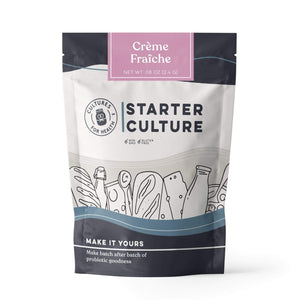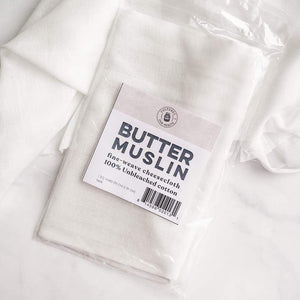
WHAT IS CRÈME FRAÎCHE?
A standard fare in France, crème fraîche is a thick, rich cultured cream, used much like sour cream. It makes a delicious topping for soups, main dishes and even desserts. The decadent texture is rich, creamy, and very satisfying.
Not only is making crème fraîche at home very easy, it allows you the option of choosing high-quality ingredients such as organic milk or cream if desired.
10 minutes
25 minutes
5 Servings
INGREDIENTS AND EQUIPMENT AVAILABLE AT CULTURES FOR HEALTH
Creme Fraiche Starter Culture

Creme Fraiche Starter Culture
$12.99
Making truly rich and mild creme fraiche at home is as easy as heating up cream or half-and-half. This direct-set culture is one of our easiest and cultures on your countertop.
Mesophilic Aromatic Type B Starter Culture
Pocket Test Thermometer
Butter Muslin

Butter Muslin
$5.99
Butter Muslin is a tightly woven cloth, similar to cheesecloth, used for draining, pressing, and straining soft cheeses, yogurt or milk kefir. Butter muslin cloth also works as a breathable jar cover for all sorts of fermenting applications.
Cheese Salt


CRÈME FRAÎCHE VS. SOUR CREAM
Both crème fraîche and sour cream are cultured cream products, While they are often used interchangeably in recipes, sour cream contains about 20% butterfat and has a sour flavor whereas crème fraîche has more butterfat and a milder flavor.
BENEFITS OF CRÈME FRAÎCHE
Here are some reasons to consider adding crème fraîche to your culturing repertoire:
- Crème fraîche has a delicious slight sour tang in flavor that is creamy, with a mild nuttiness that is less tart than sour cream.
- It can be made into whipped cream or cultured butter with ease since it is based in heavy cream.
- It doesn't separate or curdle when heated, which is ideal when you place a dollop on top of hot cobblers or stews.
- The bacteria in the cream actually aids in preservation so it tends to keep fresh in the refrigerator longer than milk or cream.
- Crème fraîche can be made easily at home, using a couple of different starter cultures.

CHOOSING A CREAM
The first step to making crème fraîche is choosing an appropriate cream for the project.
- Whipping cream (whole cream) will yield the thickest crème fraîche.
- Half-and-half can be used, but the crème fraîche will have a thinner consistency. Dry milk powder can be added as thickener, if desired.
- Raw cream can be used but will yield a thinner consistency than if pasteurized whipping cream is used.
- Avoid ultra-pasteurized (UP) or ultra-high temperature (UHT) cream, as it yields inconsistent results when used for culturing.
CHOOSING A STARTER CULTURE
For making creme fraiche, you have 2 options for a starter.
1. Crème Fraîche Starter Culture
Our Crème Fraîche Starter Culture is a direct-set culture. This means that is a single-use culture. Each packet will culture up to one quart of cream, one time. Each box contains 4 packets so you can store any extras in the freezer until you are ready to make crème fraîche again.
2. Cheese Starter Cultures
Cheesemakers may have direct-set aromatic cheese starter culture such as flora danica or mesophilic aromatic type B on hand already. Use ⅛ teaspoon powdered starter culture per quart of cream.
HOW TO MAKE CRÈME FRAÎCHE
- Warm cream slightly to 86ºF.
- Add starter culture and stir until thoroughly mixed. Do not stir longer than 15 seconds.
- Cover the container with a coffee filter or cloth, secured with a rubber band.
- Place the mixture in a warm spot, 72°-77°F, for 12-18 hours or until thickened.
- If a thicker consistency is desired, strain the crème fraîche through a tea towel or tight-weave cloth such as butter muslin.
- Once the mixture has set, cover the jar with a lid and place it in the refrigerator for at least 6 hours to halt the culturing process and cool the crème fraîche.
- Store the finished product in the refrigerator for up to a week.
STEP BY STEP PHOTO TUTORIAL

1. Warm 1 quart of fresh cream or half-and-half to 86°F.

2. Add the starter culture.

3. Mix thoroughly. Do not stir longer than 15 seconds.

4. Cover the pot and culture in a warm spot, 72°-77°F.

5. After 12 hours the crème fraîche should be set.

6. Transfer it to a container, cover with a lid, and refrigerate for up to one week.

Tada! You can now enjoy your homemade crème fraîche as a topping for desserts, or try it one of our recipes!
USING CRÈME FRAÎCHE IN RECIPES
Crème fraîche is great with just about everything. Consider serving it with smoked salmon or using it to thicken pan sauces. Try replacing some butter in mashed potatoes with a bit of crême fraîche. Add a dollop to soup, stew, or stir-fried vegetables.
Any place you use heavy cream, sour cream, cream cheese, or even butter, use crême fraîche as a partial or full replacement. You can't go wrong!

















